The Cooperative Weather Observer
The National Weather Service (NWS) has been tasked with the issuance of severe weather watches and warnings designed to protect life and property. We are also responsible for issuing river and lake forecasts and outlooks. In addition to the protection of life and property, the Department of Commerce’s National Oceanic and Atmospheric Administration (of which the NWS is a part) has been given the job of maintaining a database of climatic weather information. This too is used by the NWS in preparing medium and long range forecasts. To this end, the collection of timely and accurate surface weather data is vital.
The issuance of warnings and maintaining a national climate data-base have the Cooperative Observer Program - COOP Program in short - in common. The COOP Program is the backbone of the United States Climatological database. COOP observers may also act as weather observers and severe storm spotters, phoning in reports of hazardous weather in the winter and summer.
What is the job of a COOP observer?
Being an NWS Cooperative observer can be a challenging job. To provide accurate and complete weather data, observations are required as close to daily as possible. This does not mean that someone has to be monitoring the "weather" all the time. Yet someone should be available to record temperature, precipitation, and snowfall. This generally is done around 7a.m., but observation times can be shifted to fit the observer's schedule. This information is used to help us assess flood potential, as well as verification of our forecasts and warnings.
COOP observers are sometimes called to act as 'spotters' and are a valuable aid to the NWS by supplying information to us which advanced technology cannot readily see. An example is a spotter who reports damaging winds where the Doppler RADAR indicates damage may be occurring. Or in winter, spotters report areas where blowing or drifting snow is causing hazardous travel, yet this inclement weather is between official reporting points. These type spotters help us verify severe weather, allowing the NWS to do a better job warning the public. Both jobs are vital to the NWS and its primary function, which is the protection of life and property. This network is comprised entirely of volunteers: men and women in all walks of life; farmers and ranchers, business owners, stay at home dads and moms - the list is quite varied. The NWS Cooperative Observer is the unsung hero of the NWS, performing a vital task.
What equipment do I use?
Temperature is taken using a Maximum/Minimum Temperature System; many new ones have a 30 day memory function. This is a wired device with a bee-hive looking sensor located as far from obstructions, roadways and builds as possible to minimize false temperature readings.
The rain equipment consists of an 8 inch metal rain-gauge. The National Weather Service Representative (NWSREP) will deliver, set up and maintain the necessary equipment. Non-recording rain gauges consist of a stainless steel outer tube approximately 8 inches in diameter and 2 feet tall, with a removable funnel and inner plastic measuring tube. Precipitation is measured placing a calibrated measuring stick (supplied with gauge) into the plastic inner tube.
Both the temperature system and rain gauge are supplied and maintained by the NWS.
Snowfall is measured by taking several readings in an area that is relatively undisturbed by wind. This is the most challenging part of the COOP job, as we find it difficult to measure snowfall due to our winds. The rain-gauge is left outside during the winter season with the funnel removed. Every morning after a snowfall, the observer brings the gauge in, melts the snow and measures it to obtain a liquid content. This is important in keeping track of moisture for the flood season.
What happens with the information I collect daily?
Data must be transmitted to the local NWS office using an Internet Based program called Weather Coder, or data can be phoned in on a telephone - voice system. This near real-time data is used to support the day-to-day operations of the NWS in its forecast and warning decisions.
What kind of training is involved?
Training consists of on site, hands on instruction with the designated COOP Observer and their backup. This usually is done the same day as the equipment is installed and takes about one hour. If necessary, additional training may be provided upon request. Basic equipment maintenance is discussed and the COOP observer is provided with a name ("point of contact") and a number should additional questions or problems arise.
How are the data sent to the NWS?
We require our observers to use one of two methods – a web based form or a telephone base entry system. The internet based system is quite easy to use, while the telephone system is also fairly straight forward. The NWS will provide training as well as support to those who wish to be a volunteer observer.
Collaborative Community Rain, Hail & Snow Network (CoCoRAHs)
Another way to send information to the NWS and State Climatologist is the CoCoRAHs program. The duties of the CoCoRAHs network observer are fewer than the NWS Cooperative weather program. Basically, a CoCoRAHs observer reports only rainfall (in the summer) and snowfall (in the winter). In Minnesota this program is managed by the DNR State Climatologist Office in St. Paul.
If you are interested in being a MN-Gauge observer, please visit the Minnesota State Climatologist Office web site at
https://climate.umn.edu/doc/journal/gage_reader2009.htm
In North Dakota the program is managed by the State Climatologist, Dr. Adnan Akyuz, while in Minnesota the CoCoRaHS Program is managed by Peter Boulay Assistant State Climatologist
If you are interested in being a CoCoRaHS observer in either state, please visit the main CoCoRaHS site at
https://cocorahs.org
We encourage our observers to use the internet based CoCoRaHS web program to send rainfall and snowfall information to us. While we have a toll free line, this line is primarily used for severe weather reports, or reports of inclement weather. Using the CoCoRaHS internet site is very easy and takes only a few minutes a day.
If you have additional questions, please contact the NWS Grand Forks Coop Program Manager at 701-795-5198. Or write at:
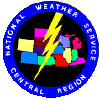 National Weather Service Eastern North Dakota/Grand Forks
National Weather Service Eastern North Dakota/Grand Forks
4797 Technology Circle
Grand Forks ND
58203-0600
FGF.Coop@noaa.gov
Or visit the NWS web page at: http://www.nws.noaa.gov/om/coop/index.htm
A variety of Equipment is used by Official NWS Cooperative Weather Observers, depending on the particular data requirement.
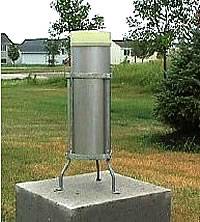 Standard Rain Gage (non recording / Manual gauge) |
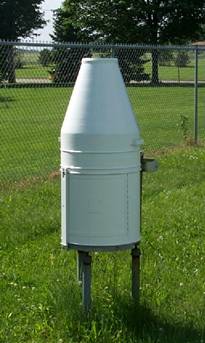 Fisher/Porter Rain Gage |
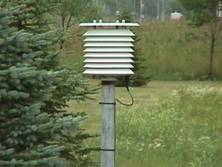 Temperature Sensor 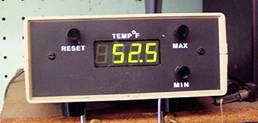 Temperature Display |
|
Rain-gage placement and reading illustrations
|
||
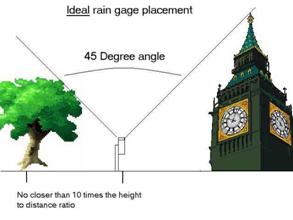 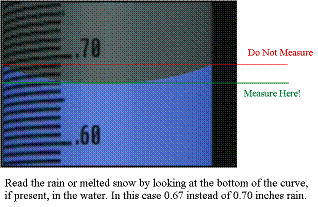 |
||